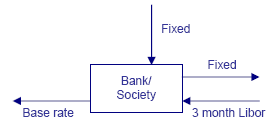
Barbican Consulting Limited
Basis Risk

A quick guide on how the Libor – Base rate differential affects retail savings and loans.
Note: Basis risk occurs when you pay one interest index and receive another. The following looks at just one aspect of a particular type of basis risk. The reference currency is GBP. Similar issues occur for retail institutions whose base currency is EUR or USD.
Libor and Base rate
The London Interbank Offered Rate (Libor) has been used for over two decades as a reference rate for both cash and derivative transactions. It is currently under the spotlight with many commentators questioning its validity as banks have been rumoured to being paying interest rates in excess of Libor to secure funding.
Whether Libor suffers demise remains to be seen. But the fact that it trades significantly higher than the Bank of England's target rate, Bank Base Rate (BBR), poses some serious issues for senior management. The following explains why you should not ignore basis risk.
Basis risk
Basis risk naturally occurs in the balance sheets of many firms.
In normal market conditions basis risk is often overlooked, the index you receive is assumed to be correlated to the index you pay and the risk is regarded as small.
Then just when you considered conditions benign it strikes. Basis risk gives you gains or losses dependent on the structure of your balance sheet. In many cases the outcome is largely one of luck rather than judgment.
Does basis risk affect you?
If you have a mixture of wholesale and retail assets and liabilities it is very likely you will be affected.
Consider a UK bank or building society. The firm has lent money to customers in the form of fixed rate mortgages. There are two potential sources of funding, wholesale and retail.
Suppose variable rate (administered rate) retail deposits provide the funding. If interest rates increase the cost of funding will rise but the mortgage rate is fixed. Most firms hedge this risk using interest rate swaps. They pay fixed interest on the swap and receive 3 month Libor.
The net position is one of receiving Libor and paying BBR (or a BBR linked rate). The interest rate risk appears to be hedged but is it? (See diagram below).

Recently 3 month Libor has been trading at a substantial premium to Base rate.
On 20th June 2008 3 month Libor was 5.95% whilst Base rate was 5.00% a differential of 95 basis points. Historically this is unusual the differential is normally in the range of 10 to 20 basis points with the gap often narrowing when markets are expecting rate cuts.
Why is Libor so high? It's the fall out from the credit crunch. Banks are finding it hard to borrow wholesale money, many markets are closed and the interbank market is at best difficult.
Windfall gains
For a firm receiving Libor and paying Base rate (as in the example) this leads to a substantial benefit. A gain equivalent to £9.5m per annum for every £1 billion hedged. (Treasury or retail lending performance is enhanced depending on internal transfers). In the current environment any windfall gain is welcome. So what's the problem?
It's an issue of dependence. It is impossible to say with any certainty how long you can rely on this additional revenue. It is largely dependent on confidence in the financial system. As long as banks find it difficult to borrow Libor rates will probably remain elevated.
Management implications
If you have senior management responsibilities you need to ask a few questions.
Are we running a basis risk?
How big is that risk?
What are the implications?
What can and should we do about it?
Your risk management department should be able to answer the first two questions by providing some straightforward explanations with the accompanying metrics.
Let's cut to the interesting stuff. Suppose you are running a significant basis risk what are the implications?
Earnings from basis risk are not a substitute for core business. Do not assume this benefit is ongoing. These are not "quality" earnings. If and when the Libor-base rate differential narrows the windfall gain will evaporate. Be prepared and don't blame the dealers.
You can afford to pay higher rates for retail deposits. Libor is higher than Base rate so you are in a situation where you can consider paying depositors rates that exceed Base rate. In order to secure retail funding some institutions are already doing this. It's one of the reasons why retail depositors are being offered some very attractive savings rates.
Consider whether hedging the basis risk is appropriate. You have alternatives-you can leave the situation as it is, hedge some of the risk or hedge all of the risk. Remember doing nothing is a decision, it implies you anticipate the differential to remain historically wide. The use of basis swaps is explained later.
Hedging may leave you worse off. If you decide to hedge and the Libor-Base rate differential widens you will be worse of than competitors with the same risk that chose not to hedge.
These issues should be discussed at the appropriate committee with the suitable action being agreed.
How does hedging work?
Basis risk can be managed with basis swaps. A basis swap exchanges one interest index for another. It's not the most liquid market but your dealers will be able to provide more information on maturity and pricing. In our earlier example if the bank decided to hedge it would pay Libor on the swap and receive Base rate.
You may be in for a surprise. Depending on prevailing prices and maturity, the swap may allow you to exchange Libor for Base rate plus a premium or margin of between 40 and 60 basis points. This is historically high (see diagram below). In effect you exchange the uncertain premium (of 90 bp) for a known premium (of 40bp) for a predetermined period of time. Is that hedge worth putting on?

Competitors may not be so well placed
If you find a decision difficult to make spare a thought for competitors that are more reliant on wholesale funding. Your windfall gain is their windfall loss.
A bank that pays Libor to borrow and then lends to retail customers on a variable rate basis (Base rate linked) is in a difficult situation.
Libor has increased relative to Base rate. Every time the bank refinances or reprices its variable rate liability margins shrink. Either the cost is passed on to the customer or earnings are depressed.
Little wonder that mortgage lending rates have been increasing.
First Published By Barbican Consulting Limited 2008